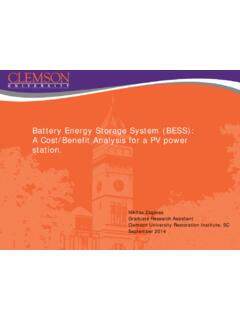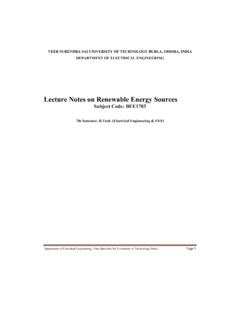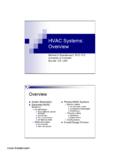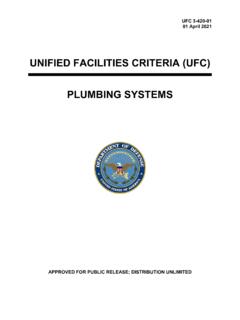Transcription of VIRGINIA DCR STORMWATER DESIGN SPECIFICATION No. 9 …
1 VA DCR STORMWATER DESIGN SPECIFICATION NO. 9 BIORETENTION Version , January 1, 2013 Page 1 of 62 VIRGINIA DCR STORMWATER DESIGN SPECIFICATION No. 9 BIORETENTION VERSION January 1, 2013 SECTION 1: DESCRIPTION Individual bioretention areas can serve highly impervious drainage areas less than two (2) acres in size. Surface runoff is directed into a shallow landscaped depression that incorporates many of the pollutant removal mechanisms that operate in forested ecosystems. The primary component of a bioretention practice is the filter bed, which has a mixture of sand, soil, and organic material as the filtering media with a surface mulch layer.
2 During storms, runoff temporarily ponds 6 to 12 inches above the mulch layer and then rapidly filters through the bed. Normally, the filtered runoff is collected in an underdrain and returned to the storm drain system. The underdrain consists of a perforated pipe in a gravel layer installed along the bottom of the filter bed. A bioretention facility with an underdrain system is commonly referred to as a Bioretention Filter. Bioretention can also be designed to infiltrate runoff into native soils.
3 This can be done at sites with permeable soils, a low groundwater table, and a low risk of groundwater contamination. This DESIGN features the use of a partial exfiltration system that promotes greater groundwater recharge. Underdrains are only installed beneath a portion of the filter bed, above a stone sump layer, or eliminated altogether, thereby increasing STORMWATER infiltration. A bioretention facility without an underdrain system, or with a storage sump in the bottom is commonly referred to as a Bioretention Basin.
4 VA DCR STORMWATER DESIGN SPECIFICATION NO. 9 BIORETENTION Version , January 1, 2013 Page 2 of 62 Small-scale or Micro-Bioretention used on an individual residential lot is commonly referred to as a Rain Garden. SECTION 2: PERFORMANCE Bioretention creates a good environment for runoff reduction, filtration, biological uptake, and microbial activity, and provides high pollutant removal. Bioretention can become an attractive landscaping feature with high amenity value and community acceptance.
5 The overall STORMWATER functions of the bioretention are summarized in Table Table Summary of STORMWATER Functions Provided by Bioretention Basins STORMWATER Function Level 1 DESIGN Level 2 DESIGN Annual Runoff Volume Reduction (RR) 40% 80% Total Phosphorus (TP) EMC Reduction1 by BMP Treatment Process 25% 50% Total Phosphorus (TP) Mass Load Removal 55% 90% Total Nitrogen (TN) EMC Reduction1 by BMP Treatment Process 40% 60% Total Nitrogen (TN) Mass Load Removal 64% 90% Channel and Flood Protection Use the VIRGINIA Runoff Reduction Method (VRRM) Compliance Spreadsheet to calculate the Curve N umber (CN) Adjustment OR DESIGN extra storage (optional; as needed) on the surface, in the engineered soil matrix, and in the stone/underdrain layer to accommodate a larger storm, and use NRCS TR-55 Runoff Equations2 to compute the CN Adjustment.
6 1 Change in event mean concentration (EMC) through the practice. Actual nutrient mass load removed is the product of the removal rate and the runoff reduction rate(see Table 1 in the Introduction to the New VIRGINIA STORMWATER DESIGN Specifications). 2 NRCS TR-55 Runoff Equations 2-1 thru 2-5 and Figure 2-1 can be used to compute a curve number adjustment for larger storm events based on the retention storage provided by the practice(s). Sources: CWP and CSN (2008) and CWP (2007) Leadership in energy and Environmental DESIGN (LEED ).
7 The LEED point credit system designed by the Green Building Council (USGBC) and implemented by the Green Building Certification Institute (GBCI) awards points related to site DESIGN and STORMWATER management. Several categories of points are potentially available for new and re-development projects. Chapter 6 and the introduction to this chapter provide a more thorough discussion of the site planning process and DESIGN considerations as related to the environmental site DESIGN and potential LEED credits.
8 However, VDCR is not affiliated with the USGBC or GBCI and any information on applicable points provided here is based only on basic compatibility. Designers should research and verify scoring criteria and applicability of points as related to the specific project being considered through USGBC LEED resources VA DCR STORMWATER DESIGN SPECIFICATION NO. 9 BIORETENTION Version , January 1, 2013 Page 3 of 62 Table Potential LEED Credits for Bioretention1 Credit Category Credit No.
9 Credit Description Sustainable Sites Site Development: Protect or Restore Habitat Sustainable Sites Site Development: Maximize Open Space Sustainable Sites STORMWATER DESIGN : Quantity Control Sustainable Sites STORMWATER DESIGN : Quality Control Water Efficiency Water Efficient Landscaping: Reduce by 50% Water Efficiency Water Efficient Landscaping: No Potable Water Use or No Irrigation 1 Actual site DESIGN and/or BMP configuration may not qualify for the credits listed. Alternatively, the project may actually qualify for credits not listed here.
10 Designers should consult with a qualified individual (LEED AP) to verify credit applicability. SECTION 3: DESIGN TABLES The most important DESIGN factor to consider when applying bioretention to development sites is the scale at which it will be applied, as follows: Micro-Bioretention or Rain Gardens. These are small, distributed practices designed to treat runoff from small areas, such as individual rooftops, driveways and other on-lot features in single-family detatched residential developments.







